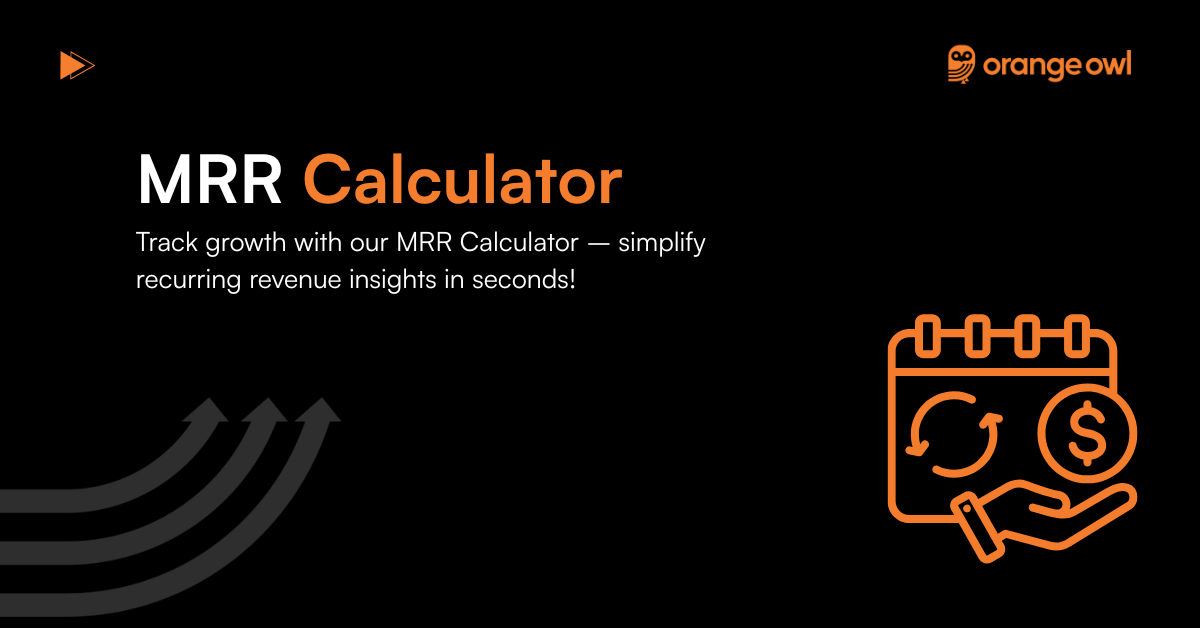MRR Calculator

Table of Contents
What is MRR (Monthly Recurring Revenue)?
MRR stands for Monthly Recurring Revenue, and it’s one of the most important metrics for SaaS and subscription-based businesses. It tells you how much predictable revenue you can expect every month from active subscriptions — a concept widely discussed in SaaS industry benchmarks.
Unlike one-time purchases, MRR focuses only on recurring payments. This makes it the foundation for forecasting growth, investor reporting, and financial health.
For example, if you have 100 customers paying ₹2,000 per month each, your MRR is ₹2,00,000. As you add, expand, or churn customers, your MRR changes.
How to Calculate MRR
The formula for MRR is straightforward:
MRR Formula:
MRR = Total Number of Active Customers × Average Revenue Per Account (ARPA)
Example:
- Customers: 50
- Average Monthly Subscription: ₹1,000
- MRR = 50 × 1,000 = ₹50,000
You can also break MRR into more detailed components for deeper insights:
- New MRR – revenue from newly acquired customers
- Expansion MRR – upgrades, upsells, or add-ons from existing customers
- Churned MRR – revenue lost due to cancellations or downgrades
- Net New MRR = New MRR + Expansion MRR – Churned MRR
What’s a Good MRR?
There’s no universal “good” MRR number—it depends on your stage, pricing model, and market. But here are general insights:
- Early-stage SaaS startups often track their MRR growth rate rather than the absolute number.
- Investors typically look for 10–20% monthly MRR growth in high-growth SaaS.
- A stable business focuses on low churn rates and sustainable expansion of MRR.
The key is not just the MRR itself, but how fast it grows and how predictable it is.
Why MRR Matters
Tracking MRR gives you visibility into the stability and growth of your business. Unlike vanity metrics (like website visits), MRR directly ties to revenue health.
MRR helps you:
✅ Forecast future revenue with more accuracy
✅ Identify how well you’re retaining and growing customers
✅ Spot issues like high churn or weak upsell adoption early
✅ Align sales, product, and marketing around growth targets
Without MRR, you’re essentially running blind when planning cash flow, investments, or hiring.
Metrics That Affect MRR
Your MRR is impacted by several related metrics:
- Customer Churn Rate: Higher churn = lower MRR stability
- ARPA (Average Revenue Per Account): Larger contracts increase MRR faster
- Expansion Revenue: Upsells, cross-sells, or tier upgrades improve growth
- Customer Acquisition Rate: More customers = higher new MRR
What Can Bring Your MRR Down?
A dip in MRR isn’t always a disaster, but you need to know why it happens. Common reasons include:
- High customer churn or downgrades
- Over-reliance on discounts that reduce ARPA
- Weak product-market fit leading to cancellations
- Seasonal fluctuations in usage or demand
If you see MRR dropping, dig deeper into whether it’s a churn problem, pricing problem, or acquisition slowdown.
How SaaS Teams Use MRR
MRR isn’t just a finance number—it’s a growth compass. Teams use it to:
- Forecast cash flow and fundraising needs
- Align GTM (Go-To-Market) efforts with revenue growth
- Track the impact of pricing experiments
- Benchmark against industry peers
Using an MRR Calculator
An MRR Calculator saves time by automating the math. Simply enter:
- Total customers
- Average monthly subscription fee
- Churn or upgrades
…and instantly see your MRR along with net changes. This helps SaaS founders validate growth strategies without complex spreadsheets.
How to Improve MRR
Improving MRR is about acquiring more customers, retaining them longer, and growing revenue per account. Some proven strategies include:
- Upsell and cross-sell: Offer add-ons, premium tiers, or bundles
- Improve onboarding: Faster activation = lower early churn
- Experiment with pricing: Find sweet spots with tiered pricing or value-based models
- Reduce churn: Engage customers before they cancel through surveys, discounts, or success check-ins
- Expand into new markets: More customers = higher MRR base
Even small changes in churn or ARPA can compound into massive long-term MRR growth.
When Should You Track MRR?
Every SaaS company—whether pre-seed or scaling—should track MRR from day one. It’s especially valuable for:
- Founders – to monitor financial runway
- Investors – to evaluate growth potential
- Sales/Marketing teams – to set acquisition goals
- Product teams – to measure if features drive upgrades or reduce churn
How Orange Owl Helps You Grow MRR
At Orange Owl, we partner with SaaS companies and subscription businesses to improve MRR sustainably. From acquisition strategies to retention programs and pricing optimisations, we ensure your growth isn’t just fast—but predictable and profitable.
Because in SaaS, recurring revenue is recurring confidence.
Frequently Asked Questions (FAQs) on MRR
No, MRR only includes recurring subscription revenue. One-time setup fees or consulting charges are excluded.
Upgrades increase MRR by adding more revenue per customer, while downgrades decrease it when customers move to lower plans.
Yes, customer churn directly reduces MRR since it represents lost recurring revenue.
Yes, discounts reduce the actual recurring revenue recognized in MRR. You should always use net revenue after discounts.
They often normalize MRR by averaging revenue across months or focus more on ARR to account for fluctuations.
